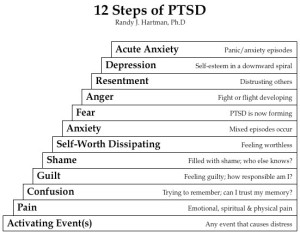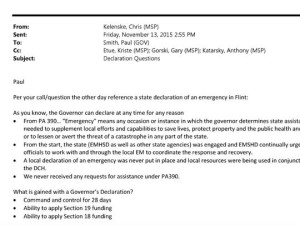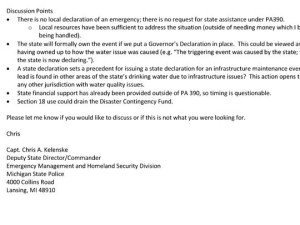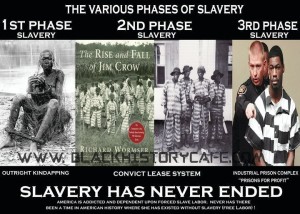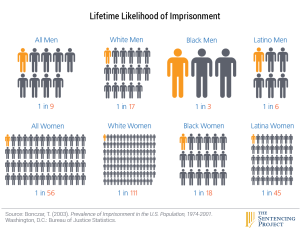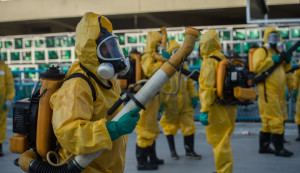What is nuclear energy you ask? Commercial nuclear power plants use a process called fission to to produce energy. Fission is essentially just splitting a large atom into smaller ones. This splitting of large atoms also releases energy. This reaction takes places inside of what is called a pressurized water reactor. The energy from the reaction in the reactor is then used to heat up water that is flowing through the system. The water is then turned to steam and the steam is able to turn a turbine. The turbine creates work and the work is used to power a generator which then releases electricity on a very large scale to the cities around the power plant. It is a very complex reaction but it utilizes the same basic process that coal plants and wind power turbines use to create electricity.

The question that usually follows now is, “what makes this energy so special?”
Nuclear energy is special because of the potential that it possesses. It has a ninety-one percent capacity factor, which is the energy that is currently produced compare to the theoretical total that it can produce. The theoretical total is just how much of the energy that the reactor is able to produce, but some of it is lost in the process, either through heat or through other sources. For comparison, coal has a fifty-eight percent capacity factor, so you can see that it is not very efficient at creating good amounts of energy, as almost fifty percent of it is lost in the process. The ninety-one percent that nuclear reactors produce is the capacity factor for the outdated designs that most nuclear power plants use today. However, newer designs can produce upwards of one hundred times more energy than the old models. Newer models are extremely efficient and can endlessly produce energy that can be used immediately. There are dozens of different reactor designs; all of which can solve the energy crisis if they become implemented. Dangerous fossil fuels, which are not energy efficient whatsoever and are harmful to both the environment and us, can finally be phased out.
You may now ask, “you say it is safer, but how much safer is it?”
With proper regulations and safety procedures in place, nuclear energy is significantly less dangerous than fossil fuels. There are heavy regulations and safety procedures in place to ensure the safety of people surrounding the plants, as well as the people that are operating them. Nuclear energy results in only about 0.04 deaths per terawatt of energy produced compared to the 161 deaths per terawatt from coal energy. A terawatt is essentially a measure of a large amount of energy produced. Nuclear power plants also result in about 0.005 percent of the radiation that is allowed per person per year. That is 100 times less radiation released than coal! Nuclear energy is easily the safest form of energy because it is an industry that is held to a very high safety standard in comparison to the coal industry or oil industry. The operators are very educated and very highly trained in all safety regulations and safety procedures. If there were any accidents, regardless of the size or impact of the accident, support for the industry would take a huge hit due to the history of the industry and the misconceptions that has been taught to the general public regarding nuclear energy. Public support is a big part in growing nuclear energy because if the general public supports it then government officials will also support it and they will increase funding and make the energy more widespread and the misconceptions will disappear.
It makes sense to be be cautious and hesitant to support an energy form that doesn’t have a great history. So I’ll try to clear up some of the misconceptions that most people have.
When most people think of nuclear energy, the first things that come to mind are the biggest disasters: Chernobyl, Three Mile Island, and Fukushima. What people don’t understand are the facts behind these disasters. Chernobyl became a disaster because the people in the government that oversaw the plant decided to do a riskier experiment. It required them to turn off all of the safety features. As a result, the plant blew up because all of the safety protocol was ignored and put aside in order to conduct the experiment. It was not a nuclear explosion that caused the plant to release enormous amounts of radiation; it was just water rapidly expanding and changing into steam. This steam was in a closed space and so it exploded. Fukushima, on the other hand, resulted from a poor design of the plant. The plant was not prepared to handle large natural disasters, so when a 20-meter-high wave, a tsunami, hit the plant, it knocked out all of the power and the operators didn’t have the proper tools to regulate the reactors. As a result, the reactors blew up much like Chernobyl did. Three Mile Island was the only disaster to occur on American soil and it resulted from a lack of communication within the industry about a faulty part within the process. Soon after the incident, the U.S. government created new agencies that would allow for the sharing of information and designs in order to prevent any of these types of disasters from happening again.
Nuclear power plants simply cannot explode like a nuclear bomb. This is because of the safety features that are built into power plants that activate automatically. The fuel is also not nearly concentrated enough to produce enough energy for a nuclear explosion. But even so, nuclear power plants are one of the most guarded places in the United States. Each plant sports no fly zones and a very wide security perimeter in order to make sure that there are no unwelcome visitors. To enforce these security features, each plant has a highly trained and heavily armed security team. Most are ex-special forces operatives so it is safe to say that each plant is in good hands. And to defend against any cyber attacks, the plants only send out information, they do not allow any incoming information which blocks any hackers from accessing any systems remotely.
“So if this energy is so safe for people and the environment, and it has such a high potential, then why has it not deemed a ‘green energy?’ Why has it not been talked about nearly as much as other alternative green energies such as solar power, wind power, and hydropower?”
This is a very complicated answer because there are many moving pieces involved with the nuclear industry. To give a short answer, it is basically because the public does not accept this form of energy so the government cannot help to advance the industry like it can for other renewable alternatives like solar and wind energy. The first step should be to label nuclear energy as a green technology because of the fact that it doesn’t harm the environment because of its lack of carbon emission. Nuclear energy is also perceived to be a very dangerous energy because of the history of it. Its history has been a huge factor in the formation of the many misconceptions that many people have. Events such as Chernobyl and the dropping of the atomic bombs on Japan have people scared to believe that this energy can be the answer to humanity’s current energy crisis. The misconceptions that people form are then transferred to younger, less informed generations in schools and to older, less informed people during protests. Most people only look at the negatives surrounding the industry and most of this information only comes from news stations that report on disasters. As a result, nuclear energy is quickly overlooked as a viable source and more money is pumped into other, less efficient sources. This makes nuclear power less viable because without government help, the capital costs for the current nuclear power plant designs are too high and so less are built. If people did more research into the topic, they would be pleasantly surprised to see how far the industry has come and how ready it is to step up and become the primary source of energy. That isn’t the only thing though. Since the nuclear energy industry is not nearly as big as the fossil fuel industries, it cannot progress and advance because money talks and the other industries have more money. The money then translates into lobbying power on Capitol Hill and the majority of the lobbying is done by fossil fuel industries. If more people put their faith in this energy, then more advancement can be done and the energy crisis will be a distant memory. The future of energy is up to people like you and me and future generations to make the right decision and to choose nuclear energy.
Imagine an abundant energy source that when used, does not produce any harmful substances. Imagine being able to produce the same amount of energy in one plant of this form of energy that takes 50 coal plants to produce. Imagine how different society would be if we could just use up as much energy as we need, without any concern of running out or doing any harm to the environment. That energy source is nuclear energy.
[1] How well does the title provocatively focus the reader’s attention, as well as the lede? Is it thoughtful, creative, clever? Does it lead the reader into the text and provide some insight into the issue?
The purpose of the title is to grab a person’s attention in order to attract them to the article. I think my title does a good job doing that because all people want answers to their problems and I proposed a solution to a problem that affects all people.
[2] How well does the introductory section of the article invite the reader into the paper, as well as offer up exigency? How does it locate a problem or controversy within a context that provides background and rationale?
The introduction starts by asking a question assuming the reader already was wondering. I then go on to explain what nuclear energy is. I started with this because it is the basis of the solution so I provided it for some background. I then proceeded to ask another question about the energy that was meant to provide the problem and then briefly provide an overview of the solution before I went into more detail as the article went on.
[3] How well does the writer offer up a strong ‘idea’ that requires analysis to support and evolve it, as well as offers some point about the significance of evidence that would not have been immediately obvious to readers.?
The basis of the entire article involves a very complicated and technical process so it must be explained. It is something that most people aren’t aware of so it needs to be put into terms so the non-technical readers can understand it.
[4] How well does the writer show clarity of thought; uniqueness of presentation; evidence of style; and historicized topics?
I’m not sure how I unique or stylish I was but my intention of the article was to present it as if I was having a conversation with the reader and I was answering the questions that they were asking.
[5] How well does the writer recognize that a NYTs Magazine audience will challenge ideas that are overgeneralized or underdeveloped or poorly explained? (that is, did the writer avoid cliché and vagueness or address points/issues readers are likely to have?) How well did the writer decide about how to develop, sequence, and organize material?
The topic is very controversial because of its past so I needed to provide proof that it can be the answer to a problem by making the proof about things that people care about, such as economics and safety.
[6] How well does the writer research a controversy, develop a persuasive stance, utilize research about the topic, and join the ‘debate’ by making an argument of importance?
I took a strong stance by claiming that nuclear energy is the answer as long as people embrace it and develop it. I provided details such as the economics and safety in order to relate with the reader and be more persuasive.
[7] How well does the writer meet or exceed research expectations of assignment requirements (6 appropriate secondary sources, 1 visual source, (or more) and primary research? ).
I did extensive research into my topic and this is shown in the amount of evidence I provided. The topic is not a basic one so I needed a strong understanding from a variety of sources if I want to persuade my audience to share my view.
[8] How well does the writer integrate secondary and primary sources (that support and complicate the topic) effectively into the text, introducing and contextualizing them, and “conversing” (i.e. no drop-quoting) in ways that deepen and complicate the analysis?
I used my sources as a way to simply prove that I wasn’t making stuff up and that real, highly educated people have proven time and time again that the view I have is a more common view than most people realize. The audience just needs to accept it.
[9 How well does the writer persuade an audience to consider claims made from a particular position of authority on which you have built your research? How strong and effective is the writer’s use of rhetorical tools (ethos, logos, pathos)?
I used questions as titles as my article progressed as a way to direct all of the information that I obtained towards a specific question. It allowed me to craft my paragraph in a way that wasn’t repetitive and so it also answered any potential questions the audience may have.
[10] How well does the writer select appropriate, interesting, revealing visual? Has the writer placed a visual strategically in the essay and provided relevant commentary on and/or analysis of them? Do the visuals contribute to the essay in meaningful ways (i.e. would the essay be affected if the writer took the visual away)?
I used a nice picture of a power plant as a way to make the plant seem more safe. I provided reasons why they are safe but I included the picture in order to allow people to visualize a safe plant. I also used a graph to back up some of the arguments that I was making and I was hoping that by showing the proof, more people would believe it.
[11] How well does the writer show development of final article using various drafts, in-class peer editing and workshops, and/or teacher comments?
I changed the order of my paragraphs a few times in accordance with the recommendation of my class mate who proof read and edited for me. I believe that he helped me tremendously to make my article flow and be more persuasive and casual.
[12] How well does the writer use hyperlinks—are they effective/appropriate?
I used hyperlinks on a couple important claims I was making because without the claims, my argument wouldn’t stand and I wanted people to be able to physically see why I was making those claims.
[13] How well did the writer edit for grammar, style, and usage effectively? Does the writer’s attention to sentence level issues help him/her establish authority or credibility on the issue?
I tried to stay away from big words and I tried to use words that I would normally use in everyday conversation so that I could continue my goal to make the article seem like a conversation between me and my audience. I of course had to use some words that I wouldn’t normally use because the topic was complex and there was no way to better explain it without some of the phrases and terms that I used.





